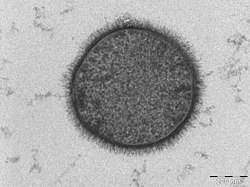| Glycocalyx | |
|---|---|
 TEM micrograph of a B. subtilis bacterium, with the hair-like glycocalyx visible surrounding the cell membrane (scale bar = 200 nm) | |
| Identifiers | |
| MeSH | D019276 |
| TH | H1.00.01.1.00002 |
| FMA | 66838 |
| Anatomical terms of microanatomy | |
The glycocalyx (pl.: glycocalyces or glycocalyxes), also known as the pericellular matrix and cell coat, is a layer of glycoproteins and glycolipids which surround the cell membranes of bacteria, epithelial cells, and other cells. It was described in a review article in 1970.[1]
Animal epithelial cells have a fuzz-like coating on the external surface of their plasma membranes. This viscous coating is the glycocalyx that consists of several carbohydrate moieties of membrane glycolipids and glycoproteins, which serve as backbone molecules for support. Generally, the carbohydrate portion of the glycolipids found on the surface of plasma membranes helps these molecules contribute to cell–cell recognition, communication, and intercellular adhesion.[2]
The glycocalyx is a type of identifier that the body uses to distinguish between its own healthy cells and transplanted tissues, diseased cells, or invading organisms. Included in the glycocalyx are cell-adhesion molecules that enable cells to adhere to each other and guide the movement of cells during embryonic development.[3] The glycocalyx plays a major role in regulation of endothelial vascular tissue, including the modulation of red blood cell volume in capillaries.[4]
The term was initially applied to the polysaccharide matrix coating epithelial cells, but its functions have been discovered to go well beyond that.
- ^ Martínez-Palomo, A. (1970). "The Surface Coats of Animal Cells". International Review of Cytology. 29: 29–75. doi:10.1016/S0074-7696(08)60032-7. ISBN 9780123643292.
- ^ McKinley, M. & V.D. O’Loughlin. Human Anatomy. McGraw-Hill, 2012. 3rd ed. p. 30-31.
- ^ Saladin, Kenneth. "Anatomy & Physiology: The unity of form and function." McGraw Hill. 5th Edition. 2010. p. 94-95
- ^ Reitsma, Sietze. "The endothelial glycocalyx: composition, functions, and visualization." European Journal of Physiology. 2007. Vol. 454. Num. 3. p. 345-359